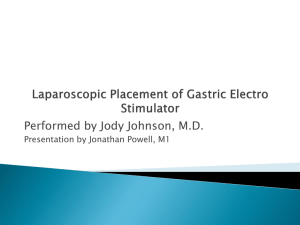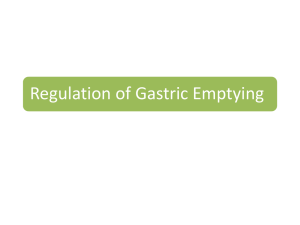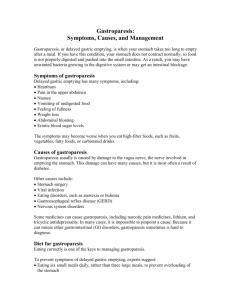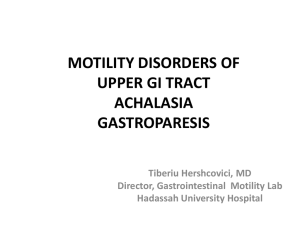Dietary Interventions for the Patient with Gastropathy
advertisement
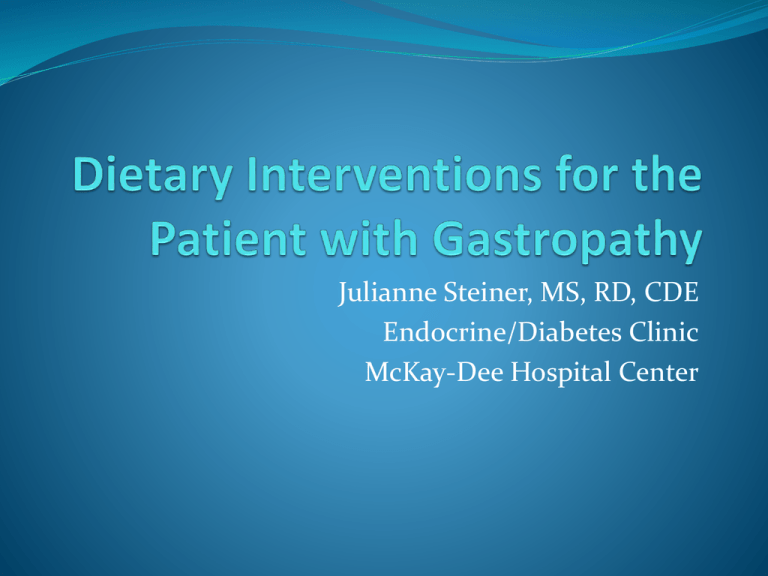
Julianne Steiner, MS, RD, CDE Endocrine/Diabetes Clinic McKay-Dee Hospital Center Objectives The participant will be able to: 1. Describe neuropathic complications of diabetes that can impact the GI tract. 2. Describe nutritional therapies that can be utilized in treating diabetic gastropathy. Normal Gastric Function Fundic relaxation to accommodate food Contractions for breaking large food particles Pyloric relaxation to allow food to exit Normal Gastric Emptying Coordinated effort between different regions of the stomach and the duodenum Extrinsic modulation by CNS and distal gut factors “Pacemaker” located on upper, outer portion of stomach. Electrical waves cause muscles to contract. Normally contracts 3 X/min. Stomach empties in 90-120 minutes after eating Gastric Emptying Rate Physical nature of food Liquid vs. solid Particle size 2 mm in diameter Fat content Caloric content High calorie liquids empty at a constant rate Gastroparesis Characterized by delayed gastric emptying in the absence of mechanical obstruction Vagal nerve conduction is diminished Reduced smooth muscle contractility Compromised myoelectrical activity Results in erratic blood glucose control Gastroparesis Estimated that up to 75% of individuals with diabetes develop some gastrointestinal symptoms Many patients do not report symptoms to doctor Patients do not realize that symptoms are related to diabetes. Gastroparesis Symptoms can last days to months or occur in cycles Poor correlation between symptoms and actual diagnosis Little evidence of a time interval between diabetes diagnosis and development of gastroparesis Gastroparesis 11%- 18% of individuals with diabetes report symptoms 25%-50% of patients with Type 1 diabetes (not correlated with nongastrointestinal complications) About 30%of patients with Type 2 diabetes Gastroparesis majority of patients are women (82%) Associated with increased BMI Not universal or inevitable Pittsburgh Epidemiology of Diabetes Complications A: Proliferative retinopathy, B: Overt nephropathy, C: Symptomatic automatic neuropathy, D: Distal symmetric polyneuropathy Pambianco, G., et al. The 30 –Year Natural History of Type 1 Diabetes Complications Diabetes 55:1463-1469, 2006 Clinical Consequences Gastrointestinal symptoms Alteration in oral drug absorption Glipizide Poor glycemic control Symptoms (nonspecific) Nausea (92%) Vomiting (84%) Bloating (75%) Early satiety Upper abdominal discomfort Reflux Unexplained weight loss Erratic blood glucose levels Delayed Gastric Emptying First sign: erratic blood glucose levels Other symptoms may be mild to severe Unexplained weight loss Prone to bezoar formation / obstruction Blood Glucose Effects Hyperglycemia slows gastric emptying Causes pyloric value to contract Decreases motility Induces gastric dysrhythmias Vicious Cycle Hyperglycemia Late hyperglycemia Delayed gastric emptying Initial hypoglycemia Blood Glucose Effects Hyperglycemia slows gastric emptying Causes pyloric value to contract decreases motility Hypoglycemia accelerates gastric emptying Important in counter-regulation of hypoglycemia Continuous inverse relationship between blood glucose levels and rate of gastric emptying. Pathogenesis Combination of factors Vagal neuropathy Hyperglycemia Unknown factors Diagnosis Consider medications that may cause gastric stasis: Anticholinergic agents Antidepressants Calcium-channel blockers Upper endoscopy to rule out obstruction Diagnosis Scintigraphy (gold standard) Calculates time to empty 50% of meal and percentage remaining after 2 and 4 hours Isotope breath tests Measures amount of CO2 in breath samples Ultrasonography Measures flow of food through pyloric sphincter Magnetic resonance imaging Nutrition Management Treatment goals: Alleviate symptoms Improve gastric emptying Enhance glycemic control Delay progression of other complications Gastroparesis Emptying of solid food is delayed Emptying of liquids remains unchanged until condition becomes more advanced Prone to development of bezoars Severity of symptoms does not correlate with degree of gastric emptying. Nutrition Management Eat smaller meals more frequently. Eat low-fiber forms of high-fiber foods, such as well- cooked fruits and vegetables rather than raw fruits and vegetables. Choose mostly low-fat foods, add small servings of higher fat foods if tolerated Avoid fibrous fruits and vegetables, such as oranges and broccoli, that are likely to cause bezoars. Nutrition Management Choose soft or liquid foods such as soups and pureed foods Drink water throughout each meal. Try mild exercise after eating, such as going for a walk. Individualize to patient’s tolerance based on postprandial glucose results Nutrition Management Avoid alcohol and tobacco Chew sugar-free gum for 1 hr after meal Nutrition Management Add nutrition supplements High nutrient liquids Enteral feedings via jejunostomy tube TPN – seldom indicated Case Study “Carol” 2/3/2011 52 yo female Type 1 Ht: 62” Wt: 140 (down 3 lbs. in 3 mo.) A1c 7.3 Blood glucose: 150-200 High BG spikes after meal Eats one meal a day Gives bolus after eating Counseled on diet for gastroparesis: -6 small meals - low fat, fiber -avoid carbonation and gas producing foods -Advised to give part of bolus before meal Case Study “Carol” 7/19/11 Wt: 141 ( up 1 pound) A1c (7/19/11): 6.8 (down 0.5) Blood glucose: majority within target range on cgms Tries to eat something for breakfast and lunch, but still skips meals ?? Nutrition adequacy Dietary Adequacy 10 Type 1 patients Mean age 44 yrs BMI 25.4 A1c 10.4 Common symptoms Bloating, nausea, halitosis, acid reflux, belching, abdominal pain, flatulence, diarrhea, anorexia, heartburn, vomiting Symptom severity did not correlate with A1c Goldberg K.B. JADA 97:420-422, 1997. Dietary Adequacy Mean energy intake: 63% of recommended levels Carbohydrate and fat reduced proportionately more than protein Calcium: 70% of recommended amount Recommend nutrition supplements to this population Goldberg K.B. JADA 97:420-422, 1997. Nutrition Management Factors which influence postprandial glucose Fasting blood glucose level Meal composition (carbohydrate) Rate of absorption from small intestine Insulin secretion/timing Hepatic glucose metabolism Peripheral insulin sensitivity Insulin Therapy Mismatch between insulin action and glucose absorption from meal Insulin peaks before glucose is absorbed Causes early hypoglycemia Later, glucose is absorbed, but no insulin Causes late hyperglycemia Insulin Treatment Strategies Rapid acting- adjust timing of injection Regular insulin before meal Delayed or extended bolus delivery with pump Monitor blood glucose frequently or use CGMS Pharmacotherapy Metoclopramide (Reglan) Stimulates stomach muscle contractions Helps reduce nausea and vomiting Taken 20-30 minutes before meals and at bedtime Long-term use is limited by development of: Tolerance Restlessness prolactinemia Pharmacotherapy Erythromycin Increases stomach contractions Given IV in acutely ill Less effective when given orally or long term ? transdermally Pharmacotherapy Botulinum toxin (Botox) Intrapyloric injection Relaxes pyloric muscle in some Benefits are temporary No efficacy in controlled studies Pharmacotherapy Domperidone (Motilium) Used to suppress nausea/vomiting Used as a prokinetic Stimulates lactation *Not approved for use in the U. S. Electrical Gastric Stimulation Uses electrical current to cause stomach contractions Surgically placed in a pocket on outer edge of stomach Enterra Therapy Pacemaker-like device Produced by Medtronic Battery operated (battery life 5-10 yrs) Implanted in abdomen Electrode connected to the stomach muscle Releases low-voltage electrical shocks every 6 seconds, causing stomach to contract Medtronic Enterra 2.2” X 2.4” X 0.4” Enterra Therapy Approved by U.S. FDA April, 2000 as humanitarian device Authorized by Federal law for use in the treatment of chronic intractable (drug refractory) nausea and vomiting secondary to gastroparesis of diabetic or idiopathic etiology. The effectiveness of this device for this use has not been demonstrated. Because of the HDE status, the system must be implanted in a medical center whose institutional review board (IRB) has approved use of the device. Surgical Treatment Rarely used Increase the size of opening between stomach and intestine Gastrectomy Long-term Management Multidisciplinary approach Patient’s understanding of how food and medicines work together Frequent blood glucose monitoring (4-8 /day) and/or use of CGMS Individualized diet according to patient tolerance Normal life expectancy after adjustments for other disorders Thank You!


